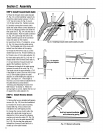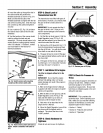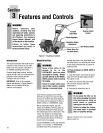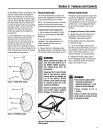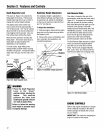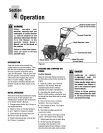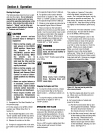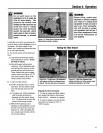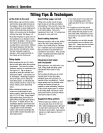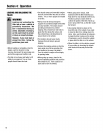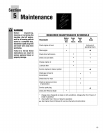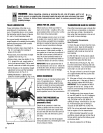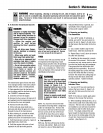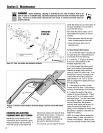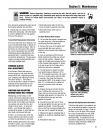
Section4: Operation
TillingTips& Techniques
Letthetiller dothe work
• While tilling, relaxand let thewheels
pull the tiller along while the tines do
the digging. Walk on the side that is
not yet finished (to avoid making foot-
prints in the freshly tilled soil) and
lightly, but securelygrip the handlebar
with just one hand.SeeFigure4-2.
• Avoid the temptation to push down on
the handlebarsin an attempt to force
the tiller to dig deeper. Doing so takes
the weight off the poweredwheels,
causing them to losetraction. Without
the wheels helping to hold the tiller
back,thetines will attempt to propel
the tiller backwardtoward the
operator- often causing thetiller to
skip rapidlyacrossthe ground.
Tilling depths
• When preparing the soil, till a fresh
pathon eachpass ratherthan overlap-
ping passes. This gives the wheels
maximum traction on undisturbed soil.
See Figure4-6. Digasdeeplyas
possible on eachpass without over-
loadingthe engine. Later passescan
be overlapped. (Watering the garden
area afew days prior to tilling will
maketilling easier,as will letting the
newly worked soil set for a day or two
beforemaking a final, deeptilling
pass.)
• Whencultivating (breakingupthe
surfacesoil around plantsto help
destroyweeds),adjustthe tines to dig
only 1-1/2"to 2"deep. Using shallow
tilling depthshelpspreventinjuryto
plantswhose rootsoften growcloseto
the surface. If needed,Iiftup on the
handlebarsslightly topreventthetines
from digging toodeeply. Cultivatingon
a regularbasisnotonlyeliminates
weeds,it alsoloosensandaeratesthe
soil for bettermoistureabsorptionand
fasterplantgrowth.
Avoidtilling soggy,wetsoil
Tilling wet soil often results in large,
hard clumps of soil that can interfere
with planting. If time permits, wait a day
or two after heavyrains to allow the soil
to dry beforetilling. Test soil by
squeezing it into a ball. If it compresses
too easily,it is too wet to till.
Avoidmakingfootprints
Wheneverpossible,walk on the untilled
side of the unit to avoidmaking foot-
prints in your freshlytilled or cultivated
soil. Footprintscausesoil compaction
that canhamperroot penetrationand
contribute to soil erosion. Theycanalso
"plant" unwantedweedseedsback into
the freshlytilled ground.
Choosingcorrectwheel
andtine speeds
With experience,you will find the "just
right" tilling depth and tilling speed
combination that is bestfor your
garden.
Set theengine throttle leverat a high
enough speedto givethe engine
adequatepowerand yet allow it to
operatewithout overloadingit. Fastest
engine speedsmay bedesirablewhen
makingfinal passesthrough the
seedbedor when cultivating. Selection
of the correct enginespeed,in relation
to thetilling depth, will ensurea suffi-
cient power levelto do the job without
causing the engineto labor.
Suggestedtilling patterns
• When preparinga seedbed,go over
the same pathtwice in thefirst row,
then make individual passesright next
to each other (seeFigure4-6). When
finished in one direction, makesecond
passesata right angle asshown in
Figure4-7.
In very hard ground it may takethree
or four overlapping passesto thor-
oughly pulverizethe soil. (SeeFigure
4-8.)
• If the garden sizewill not permit
lengthwiseand then crosswise tilling,
then overlapthe first passesby one-
halfa tiller width, followed by succes-
sive passesat one-quarterwidth (see
Figure4-8).
• With planning,you canallow enough
room between rows to cultivate (see
Figure4-9). Leaveroom for the hood
width, plusenough extra roomfor
future plantgrowth.
Figure4-6
Figure4-7
Figure4-8
Figure4-9
16



